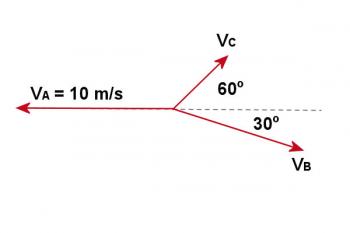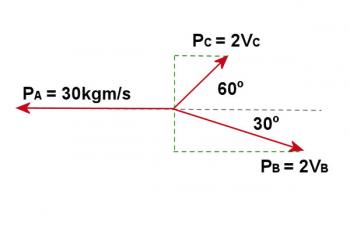Conservation of Momentum
Reference > Science > Physics > Study Guide > Unit 5: MomentumThe principle of conservation of momentum is a direct consequence of Newton's third law. Newton's third law says that if object A exerts a force on object B then object B will exert an equal force back on object A. If object A accelerates in one direction B will accelerate in the other. The accelerations will not necessarily be equal since the masses may be different but since the two forces obviously act for the same time the impulses applied on the two objects are equal and opposite. Therefore the changes in momentum are also equal and opposite, and the total of the momenta of the two objects will not change. In this case we say that momentum of the system is conserved. In general, in any closed system the total momentum of the objects in the system can not change. Any time one object gains some momentum one way, another object (or combination of objects) gains an equal amount of momentum in the other direction.
It is easy to suggest situations in which it seems that the momentum is not conserved. For example, a stone thrown vertically upward has an upward momentum which decreases to zero and then increase in the downward direction. The momentum of the object is clearly not conserved. The problem here comes because the stone is not a closed system. To have a closed system we must include the earth with the stone. The same force that acts on the stone slowing its vertical motion acts on the earth, producing an equal change in the momentum of the earth. The mass of the earth is so large by comparison to that of the stone that its motion seems to be negligible but nevertheless the earth's motion is required by application of the principle of conservation of momentum.
Conservation of momentum is very useful in the solution of problems involving the explosion of an object with small objects flying away in various directions. When a rifle is fired, the momentum of the bullet is exactly equal and opposite to the recoil momentum of the rifle. If the respective masses of the objects and the velocity of one of them is known then the velocity of the other can be easily found.
Another useful application of the principle of momentum is in the solution of problems involving collisions between two or more objects. If the masses of two objects and their velocities before a collision are known, it is possible to calculate the velocity of one of the objects after the collision if the velocity of the other is known. Note that this does not allow us to determine the final velocity of both objects, we can only find the velocity of one if the velocity of the other is known.
Since momentum is a vector it is possible to have problems where the motion of the objects is not all along a line. In this case it is necessary to calculate components of the momenta of the objects before and after the collision. The total Xâcomponents before the collision must be equal to the total of the Xâcomponents of the objects after the collision. In the same fashion the total of the Yâcomponents must also be the same before and after the collision.
Sample Problem #1
A rifle has a mass of 2 kg and fires a 50 g bullet at a speed of 1000Sample Solution #2
2Vg = 0.05(1000)
Vg = 25
This is a very simple problem. The hardest part is recognizing that this problem is going to be solved using the principles of conservation of momentum. You might question as to whether we have a closed system. As a matter of fact we do not. In order to be truly closed we would have to consider the gas involved in the explosion. However, the mass of this gas is so small in comparison to that of the gun and bullet that it may be safely neglected. You also might question as to whether we need to consider gravity in this problem. Not really. The pull of gravity is at right angles to the forces on the gun and bullet so will have no effect on their initial velocities. To be sure, as soon as the bullet leaves the barrel of the gun gravity will give it a downward component of velocity and the earth a corresponding upward component. However, this does not have any effect on the velocity of the bullet at the instant that it leaves the barrel of the gun. Air friction will also slow the bullet down but this takes place after we have completed the problem.
Sample Problem #2
A 7 kg object in outer space explodes into 3 fragments. The masses of the fragments are 3, 2, and 2 kg. Their velocities all lie in a plane. The 3 kg mass has a velocity of 10Sample Solution #2
As seen from the table above and the vector diagrams below, the motion of one of the objects has been placed along the negative xâaxis for convenience. The velocity vectors are shown in figure 5.2.1 and the momenta vectors are shown in Figure 5.2.2.

Figure 5.2.1

Figure 5.2.2
Since the object was initially at rest, the initial momentum was zero. After the explosion the total momentum of the three objects must still be zero. The momentum vectors have been resolved into components which are horizontal and vertical on the page. Since the total momentum must be zero then the total of the horizontal components must be zero. Therefore the sum of the two components to the right must be equal to the component to the left as follows:
It is also necessary that there be no component up or down the page, therefore:
The second equation can be solved for VB to give:
Substituting this in the first equation we obtain:
VB = 9.9
Questions
 Impulse - Momentum
Impulse - Momentum Elastic Collisions
Elastic Collisions
